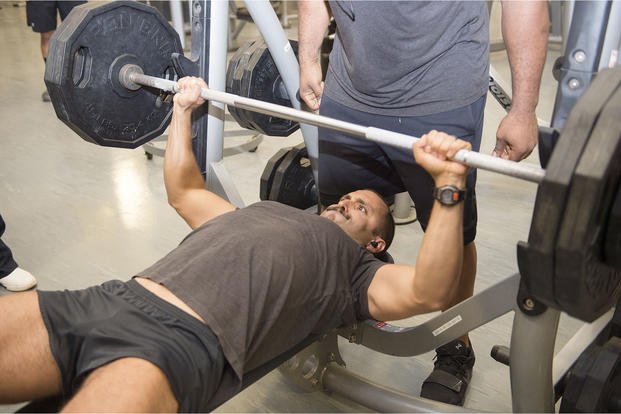There is a fine line between fatigue and failure and between optimal and suboptimal workouts. There’s an even more important line -- the one between mentally tough and stupid. Crossing that line can lead to pain and injury.
When your training is so focused on crushing PT tests to earn the scores that will get you accepted into spec ops selection programs, you can cross that line. You also can find yourself over the line as you push the limits to make it through the selection process.
If you avoid crossing these lines, you can stay healthy, recovered and well-prepared. The last thing you need during a training cycle is downtime because of an injury that could have been avoided.
Fatigue and failure: Accumulating a high number of repetitions to build muscle stamina and work capacity can be done with several sub-max-effort sets, pushing a level eight out of 10 on the Rate of Perceived Exertion (RPE) scale.
Using the pyramid is a good way to accomplish this, since there is a peak that is good for pushing perceived limitations. However, these high-repetition workouts also can be done with every set going beyond the fatigue zone and ending when you attempt and fail at the final repetition of each max rep set.
This burnout set can be both painful and euphoric, but it only teaches our bodies to be able to push hard for 30 minutes and fails to consider the bigger picture of why you may be training in the first place.
When pushing into the failure zone, the chances of injury are much higher, especially if you’re doing weighted exercises. Injuries are caused by pushing or pulling hard in one direction when the weight or your body is moving in the other direction. Failure is not the answer, but fatigue is.
Optimal or suboptimal: Tactical athletes need to understand that there is no 30-minute metabolic conditioning that will prepare you for a full day of special ops training. You must be able to put in the time in the aerobic state through conditioning that will include running, swimming, rucking, high-repetition calisthenics, load-bearing activities and equipment-carry activities.
Building this kind of aerobic machine takes time. Running a five-minute mile might be possible for you once, but you might fall over when it is done. However, some athletes run full marathons at a sub-five-minute mile pace by extending their aerobic zone through high-level training.
When training for long days of selection, your ability to work through the different energy systems, refuel and pace aerobically for long periods of time is critical to your survival each day.
Your ability to recover from high-volume workout loads will depend on the methods you use to achieve this volume, your nutrition, hydration and sleep. Put any of these out of balance, and your recovery will be at risk. That is a suboptimal outcome, regardless of how you used your energy performing all the day’s tasks.
Mentally tough and stupid: Highly conditioned athletes can push the boundaries of mentally tough or stupid through sheer volume of miles, reps or time. It is when these miles, reps and time training go past previous training volumes. However, an unconditioned person who attempts the same amount of volume could find themselves suffering from debilitating soreness or even rhabdomyolysis.
Your appropriate workout volume at the end of a training cycle depends on recovering completely each day. If you miss a training day due to burnout, under-recovery, aches, pains or injuries, you will never accumulate the desired weekly or monthly volume required to become the aerobic machine you need to be. If you constantly push yourself into the “gut-check” zone when training, you can push past that line between mental toughness and stupidity.
Perfect case study on mentally tough vs. stupid and pain and injury: I had a few students decide they were going to run a 100-mile race (century run) one year. Knowing they had not prepared for it (or even done a marathon), I did not recommend it.
While they ran 100 miles during a weekend, everyone else (myself included) continued our 25-mile-a-week training program. The following week, one of the 100-milers suffered a stress fracture in their foot, and another’s hip pain forced them to stop running for the next two months.
Meanwhile, the rest of us were running 100 miles a month for the next two months. We had accumulated 200 miles during the time they hobbled through 100 miles during a single weekend. After two months with no running, it took them another three months to get back to where they were before the 100-mile run.
Was the gut check worth losing out on five months of higher-performance training? I do not think so. You build mental toughness one day at a time, not in one day. The daily grind of five months of training while you deal with the quit demon each day is far more valuable than a gut check that injures you for five months.
The goal when training hard is stay on the right side of pain and injury. You can do that if you focus on the lines between fatigue and failure, optimal and suboptimal and, of course, mentally tough and stupid.
Stew Smith is a former Navy SEAL and fitness author certified as a Strength and Conditioning Specialist (CSCS) with the National Strength and Conditioning Association. Visit his Fitness eBook store if you’re looking to start a workout program to create a healthy lifestyle. Send your fitness questions to stew@stewsmith.com.
Want to Learn More About Military Life?
Whether you're thinking of joining the military, looking for fitness and basic training tips, or keeping up with military life and benefits, Military.com has you covered. Subscribe to Military.com to have military news, updates and resources delivered directly to your inbox.


















